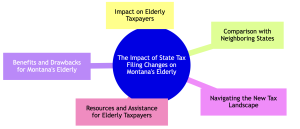
Comparing Elder Law: Montana vs. Neighboring States
February 18, 2024
Montana Estate and Trust Administration: A Guide for Families
February 18, 2024Montana’s state tax filing changes mark a significant shift in how the elderly will manage their finances. These adjustments, aimed at simplifying the tax code and potentially lowering the tax burden for many, have sparked a conversation about their broader implications. For Montana’s elderly population, staying ahead of these changes is crucial for effective financial planning and safeguarding their economic well-being.
Key Takeaways
- Recent tax filing changes in Montana include adjustments to brackets and rates.
- These changes have a direct impact on the financial health of the elderly.
- Montana’s approach differs from neighboring states, affecting comparative tax burdens.
- Seniors may see both benefits and challenges under the new tax regulations.
- Various resources are available to help Montana’s elderly navigate these changes.

Overview of Recent State Tax Changes in Montana
Montana’s legislature has enacted significant tax changes, aiming to modernize the tax system and potentially reduce the tax liability for its residents, including the elderly. These changes encompass a broad spectrum, from adjusting tax brackets and rates to modifying deductions and credits available to taxpayers.
Comparison of Tax Systems: Before and After
| Aspect | Before Changes | After Changes |
| Tax Brackets | Multiple brackets with varying rates | Consolidated into fewer brackets with adjusted rates |
| Standard Deduction | Set amount for all filers | Increased deduction for senior citizens |
| Tax Rates | Higher rates for higher income brackets | Reduced rates across the board |
| Deductions for Seniors | Limited deductions specific to the elderly | Expanded deductions, including for healthcare costs |
| Credits | Fewer tax credits available | Introduction of new credits targeting the elderly |
These adjustments reflect Montana’s commitment to creating a more equitable and less burdensome tax environment for its aging population. By simplifying the tax structure and offering targeted benefits for seniors, Montana aims to enhance the financial security of its elderly residents, making it an attractive state for retirement.
Impact on Elderly Taxpayers
Montana’s recent tax changes bring both opportunities and challenges for its elderly residents. With the state’s adjustments to tax brackets, rates, and deductions, seniors are looking at a different financial landscape. These changes are particularly significant for those on fixed incomes or managing retirement savings.
- Increased Standard Deduction: Offers more non-taxable income for seniors.
- Medical Expense Deductions: Expanded eligibility for deducting healthcare costs.
- Retirement Income Taxation: Adjustments in how retirement income is taxed, potentially lowering tax bills.
- Property Tax Relief: Enhanced relief programs for senior homeowners.
- Credits for Elderly: Introduction of new tax credits aimed at supporting the elderly population.
These areas are crucial for Montana’s seniors, affecting everything from daily living expenses to long-term financial planning.
Montana’s State Tax Filing: Comparison with Neighboring States
Tax Policies for the Elderly in Idaho
Idaho maintains a balanced approach to elderly taxation, with specific credits and exemptions aimed at reducing the tax burden on seniors. However, it lacks the targeted deductions for medical expenses seen in Montana.
Wyoming’s Approach to Elderly Taxation
Wyoming, with no state income tax, offers a favorable tax environment for all residents, including the elderly. This broad policy contrasts with Montana’s more nuanced approach to specifically supporting seniors.
North Dakota’s Tax Regulations for Seniors
North Dakota provides a mix of tax benefits for the elderly, including property tax credits and income tax exclusions on pensions. While comprehensive, it doesn’t match Montana’s expanded healthcare deductions.
Benefits and Drawbacks for Montana’s Elderly
Montana’s tax changes are a double-edged sword for the elderly population. While aiming to reduce the overall tax burden, the specifics of these changes can have varied impacts on different segments of the senior community.
Analysis of Benefits and Drawbacks
| Aspect | Benefits | Drawbacks |
| Standard Deduction | Increases disposable income | May not cover rising living costs |
| Medical Deductions | Eases healthcare expense burden | Complex eligibility criteria |
| Retirement Income | Potentially lower taxes on pensions | Confusion over new tax treatments |
| Property Tax Relief | More savings for homeowners | Limited help for renters |
| New Credits | Direct financial support | Requires awareness and understanding to claim |
Understanding these nuances is crucial for Montana’s elderly to navigate the tax changes effectively, maximizing benefits while mitigating any potential drawbacks.
Navigating Montana’s State Tax Filing in 2024
Montana’s elderly face a new tax landscape, filled with both challenges and opportunities. Adapting to these changes requires a proactive approach to tax planning. Here’s how seniors can stay ahead:
- Review the New Tax Brackets: Understand how your income fits into the updated tax structure.
- Maximize Deductions: Identify any increased deductions you’re eligible for, especially those related to healthcare.
- Consult a Tax Professional: Seek advice from experts familiar with Montana’s tax changes.
- Explore Property Tax Relief Programs: Determine if you qualify for enhanced property tax benefits.
- Stay Informed: Keep up with any further updates from the Montana Department of Revenue.
Effective tax planning under the new rules can help mitigate potential drawbacks and leverage benefits.
Resources and Assistance for Elderly Taxpayers
Montana’s elderly have access to a wealth of resources and assistance designed to ease the transition under the new tax laws. State-provided services offer guidance and support, ensuring seniors can navigate these changes with confidence. Tax assistance programs, available through local community centers and nonprofit organizations, provide valuable help in understanding and applying the new tax regulations. Additionally, educational resources, including workshops and online materials, are readily available to keep Montana’s seniors informed about the latest tax changes and planning strategies.
State agencies and local nonprofits are committed to supporting the elderly through this transition, offering personalized advice and assistance to ensure they understand their tax obligations and opportunities.
Key Resources Available to Seniors For Tax Assistance and Education.
| Resource | Description | Contact Information |
| Montana Department of Revenue | Offers comprehensive information on tax changes and filing requirements. | Revenue Website |
| Montana Legal Services Association (MLSA) | Provides free legal advice on tax matters to eligible seniors. | MLSA Website |
| Area Agencies on Aging | Local agencies offering tax counseling and assistance for seniors. | Find Your Local Agency |
| AARP Tax-Aide Program | Offers free tax help to individuals 50 and older who cannot afford a tax preparation service. | AARP Tax-Aide |
| Senior Citizen Property Tax Assistance Program | Provides property tax relief to eligible senior homeowners. | Property Tax Assistance |
| Montana Elder Law, Inc. | Specializes in legal assistance for seniors, including tax issues related to estate planning and retirement. | Montana Elder Law |
Wrapping Up: Montana’s State Tax Filing
The recent tax changes in Montana present a new reality for the state’s elderly population, emphasizing the need for careful tax planning and awareness. These changes, while aimed at simplifying the tax process, require seniors to stay informed and proactive in managing their finances. Resources and assistance are plentiful, ensuring that Montana’s elderly are not left to navigate these changes alone.
Montana Elder Law is a trusted resource for Montana’s Seniors. If you have any questions about any Elder Law topics, contact us today!

